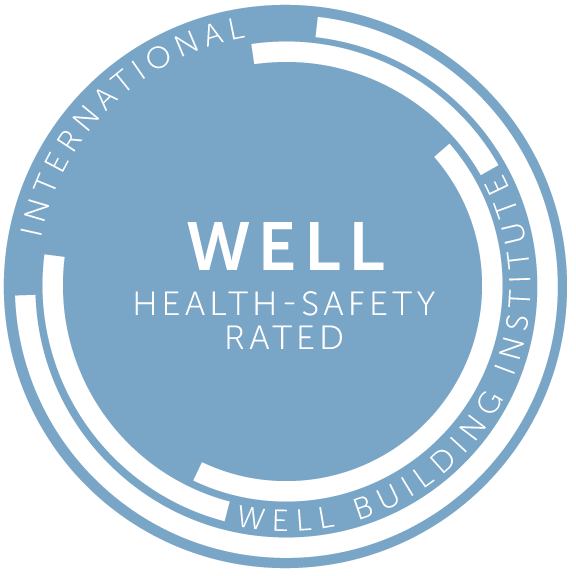Current Fellows
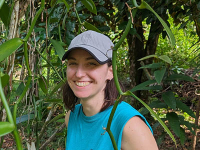
K Brinson
NC State University, Raleigh, NC
Ethnobotany of Stingless Beekeeping by the Maya of Belize
This research aims to document the traditional knowledge of the Maya who practice stingless beekeeping and explore its potential agricultural applications in Belize. Meliponiculture—the ancient practice of stingless beekeeping—has been integral to Maya culture for centuries, but it is rapidly declining due to urbanization, deforestation, and other environmental pressures. Despite its importance for spiritual, medicinal, and agricultural purposes, meliponiculture remains under-researched. Unlike the introduced European honeybee (Apis mellifera), stingless bees are native to Central America and show promise as pollinators for crops cultivated by local Maya communities, offering valuable alternatives in a changing climate. European honeybees are increasingly unable to meet agricultural demands, particularly in tropical environments, where they face numerous challenges. As a result, alternative pollination strategies are essential to improve food security, health, and economic stability. However, much remains unknown about the benefits of stingless bees, and further research is needed to identify their full potential in agriculture and medicine. The medicinal properties of stingless bee honey and sustainable farming innovations depend on preserving both the species and the traditions tied to them. This project is unique in its focus on sustainable agricultural solutions that support biodiversity while respecting cultural heritage. By emphasizing practices that promote both ecological and cultural sustainability, this research aims to offer viable alternatives to monocrop farming while addressing global food security challenges through ethical, interdisciplinary approaches in collaboration with indigenous communities.
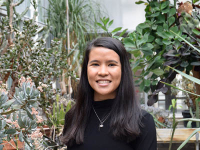
Rosebelle Ines
Binghamton University, State University of New York
Using ant-mediated seed dispersal to restore and augment wildflowers in secondary forests of New York
Present-day forests in eastern North America have experienced widespread historical damage when previously cleared for agriculture and timber. While forest canopies have recovered, previously cleared forests lack understory forest floor plants, particularly wildflowers. Approximately 30% of eastern North American forest wildflowers, including violets, wild ginger, trillium, and bloodroot, rely on ants to spread their seeds. Understory wildflowers are important in forest ecosystems, contributing to regulating nutrients and water, serving as homes and food for other organisms, and having cultural, aesthetic, and recreational value to Native American communities and the public. Other changes influenced by people including higher deer abundances and warming temperatures also affect these plants negatively. Here, we aim to restore wildflower populations in previously cleared forests in New York. This is a collaborative project between Binghamton University and New York State Parks, and together we have planted wild ginger and bloodroot plants inside and outside deer fencing areas at two forest locations with public access, and will develop restoration plans for an additional location in 2025. After restoration, we will examine if seed dispersal by ants, and environmental conditions, including if deer have access to plants or not, influences restoration success. We use these restoration efforts as an opportunity to work with natural resource managers, provide opportunities for trainees, and to engage the public about the importance of herbaceous plants and the relationships among organisms in New York.
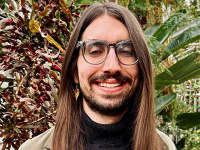
Joey Jaros
The Ohio State University
Incorporating Environmental Context into a model of Alliaria petiolata Population Dynamics to Predict Invasion Impact and Improve Management Efficiency
Climate change may threaten epiphytes, which are plants that live non-parasitically on trees such as some species of orchids, bromeliads, and ferns. However, these predictions generally depend on maps of current and future climates that may not represent the climatic conditions that epiphytes experience due to their coarse spatial scale. In tropical rainforests, microclimate variation from the understory to the upper canopy and across elevations influences where different epiphyte species occur. For example, shadier, cooler, and wetter microhabitats in the inner canopy contain different epiphyte species than sunnier, hotter, and drier microhabitats in the outer canopy. Yet, we do not have a good understanding of how these microclimates may influence vulnerability of epiphytes to climate change. I therefore propose to examine impacts of microclimates on epiphytes under current and future climate conditions across a mountain slope in Cerro Chucanti Reserve in the Darien Province of Panama to improve predictions of climate change impacts. To do so, I will monitor microclimate variation in the forest canopy across elevations, predict future microclimates based on these measurements, and examine how microclimates influence epiphyte distributions across the mountain slope. The results of the research will improve our understanding of the mechanisms driving patterns of epiphyte diversity and how climate change may impact epiphyte communities in the future.Humans have introduced many plants to areas that they are not originally from. Some introduced species become invasive by spreading rapidly in the new environment and causing negative impacts. Garlic mustard is a highly invasive herb that many people have helped control through community service like weed pulling. While Garlic mustard can reduce native plant and insect diversity, it does not cause the same impact everywhere it is found. Predicting where it will have the most consequences or what management will provide the best control is difficult. Different forms of the plant, like seedlings vs flowering adults, will respond differently to environmental variation, meaning we need to account for the whole life cycle of the plant to best predict where it could spread in the future. This project will create a model of garlic mustard population growth that accounts for its life cycle and environmental variation. We are currently monitoring mustard populations in 48 unique plots to measure how individual mustard plants respond to differing environments, such as variation in light availability, climate, and soil nutrients. From this individual level data, we will build a larger model that predicts how whole mustard populations will grow or shrink depending on environmental conditions. By explicitly connecting the environment to plant performance, this model will be able to predict which areas are at risk of garlic mustard invasion, which sites to prioritize for control, and if the effectiveness of control (like pulling or herbicide) vary based on the environment.
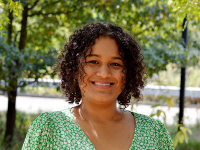
Viviana Londoño-Lemos
University of Minnesota
Tolerate, Avoid or Die: Discovering the Germination Strategies of Tropical Dry Forest Species in a Changing World
Like us, a plant's most important moment in life is its birth. Imagine a new plant emerging in a forest: this moment will decide where it will grow and live permanently. Since most plants remain rooted in one place, where they germinate will be their home until the end of their days. So, unsurprisingly, plants take seed germination very seriously. Seeds act like weather sensors that can detect changes in light, temperature, or water, indicating the best time to germinate. However, with the unpredictable weather shifts caused by climate change, seeds might get confused signals to germinate. Understanding whether this is happening is crucial for threatened ecosystems such as the tropical dry forest (TDF) because they depend on germination to restock the forests. TDF are unique tropical ecosystems because they experience distinct dry and rainy seasons, limiting the germination period and making them vulnerable to climate change. I will try to get to the bottom of this with seeds collected in Colombian and Costa Rican TDFs. In my experiments, I will examine how water availability and temperature affect germination. I will also explore if some seed traits can help us predict if TDF seeds will tolerate, avoid, or die under these climatic stressors. I aim to identify which species are most vulnerable to climate change and thus should be prioritized for propagation in restoration efforts. My research will help design better conservation and restoration strategies to save the TDF, one of the world’s most threatened tropical ecosystems.
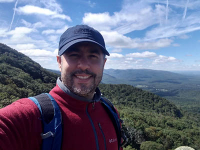
Pablo Lopez-Bustamante
Virginia Commonwealth University
Exploring the interactions between canopy gaps and invasive plant communities in northeastern hardwood forestsInfluence of Density-Dependence and Resource Partitioning on Dispersal Syndromes in a Tropical Dry Forest under Climate Change
Seed dispersal is how plants move their seeds to new areas, often through wind or animals like birds and mammals. This process helps plants spread, avoid predators or competition, and allows forests to recover after disturbances. The success of colonizing plants depends on their use of resources like moisture and temperature and the abundance of competitors such as neighboring species, shaping how forests respond to climate change. In tropical dry forests, younger forests are dominated by wind-dispersed species, while older ones by animal-dispersed species. In Costa Rica’s Santa Rosa National Park’s dry tropical forest, studies reveal that many plant species are disappearing as rainfall decreases and temperatures rise, while drought-tolerant species are thriving. Surprisingly, the balance between wind- and animal-dispersed plants has remained stable over time. This research will explore how neighboring plants, water use, and heat tolerance influence these species’ stability, using long-term data from a tropical dry forest’s vegetation plot in Costa Rica. I expect that neighboring plants benefit wind-dispersed species while hindering animal-dispersed ones by increasing direct competition for resources, with effects varying by plant age and drought tolerance. As an educational component, I will host workshops that blend ecology and music to connect people with nature. Participants will (1) compare forests to musical ensembles, (2) observe and sonify forest sounds through guided tours, and (3) create a musical composition inspired by the ecological concept of competition, fostering a deeper appreciation for biodiversity.
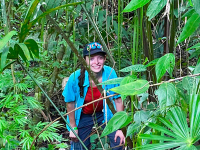
Gabriela Quesada-Ávila
University of South Florida
Hot friends or hot enemies: the role of soil-borne fungi on seed germination and survival
Once upon a time, on a vibrant planet full of life, humans developed habits that slowly warmed their world. This heating disrupted the balance of life, threatening ecosystems like tropical rainforests, where plants already live near their thermal limits. If temperatures continue to rise, many plants may not adapt in time, menacing the survival of these extremely diverse forests. Seeds, a critical stage in a plant’s life cycle, carry the potential for new growth and can “sense” environmental changes that trigger germination. This is where my story begins. As a plant ecologist, I want to understand: How will seeds of tropical trees adapt to a hotter world? What about the unseen world beneath our feet? Below the forest floor lies a community of soil microorganisms, particularly fungi, which are vital to understand seed’s survival. These interactions can support or hinder seed survival, but how will rising temperatures affect these relationships? To find answers, I am leveraging a groundbreaking experiment in the Panama rainforest, where scientists have warmed the soil with electric heaters at the Barro Colorado Island. Using this setup, I will bury seeds of three tropical tree species for three months to evaluate how they perform under different temperatures. Will they germinate? Will the fungi help them? Or will the heat rewrite the rules of their ancient partnership? This experiment will help us understand how tropical forests might adapt—or struggle—in a warming world, hoping to find new ways to protect the delicate balance of life on our planet.
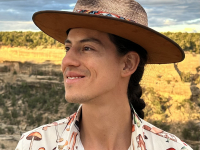
David Felipe Rodríguez Mora
The University of Texas at San Antonio
The Cofán-Yagé (a.k.a. Ayahuasca) Lianas Shapeshifting Relations: How Yagé Tourism Has Changed Cofán-Yagé Lianas’ Interactions, Understandings, and Shamanic Knowledge
This project explores how the growing popularity of Yagé tourism has impacted the Indigenous Cofán People of Sucumbíos, Colombia, and their relations with Yagéa group of lianas in the acerola family used in Amazonian shamanism. Yagé tourism, a growing economic sector for the Cofán in Colombia and Ecuador, has led to the Yagé lianas’ increasing global demand. While this has provided income for the Cofán, it has also led to the uncontrolled harvesting of wild Yagé populations, raising concerns about the lianas’ long-term survival in the Amazon rainforest. This study combines plant sciences and cultural studies to understand how Yagé tourism has influenced the Cofáns’ knowledge, identity, and relations with Yagé and associated shamanic plants. It examines how the Cofáns classify and understand the Yagé lianas, their shamanism practice, and their socioenvironmental relations in contrast with Western perspectives. By studying the cultural and socioecological attributes of Yagé, the research aims to bridge Indigenous and Western science’s interpretations of the nature of being and knowledge, advancing the plant’s conservation and the Cofáns’ biocultural sovereignty.
Top photo © Paul g. Wiegman

